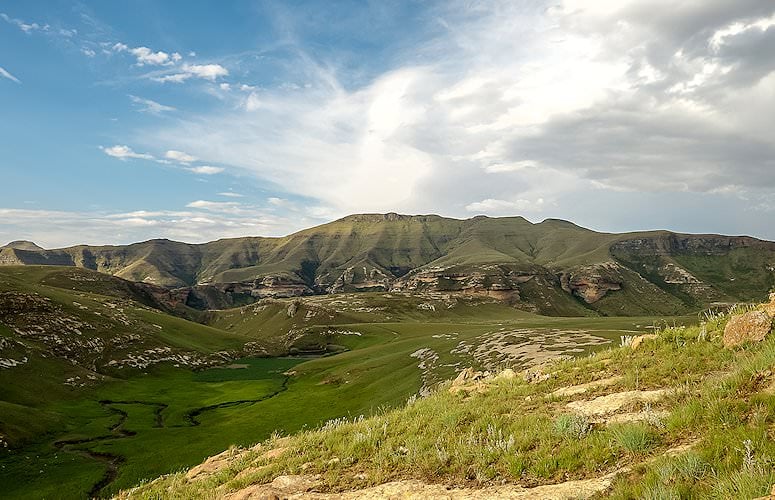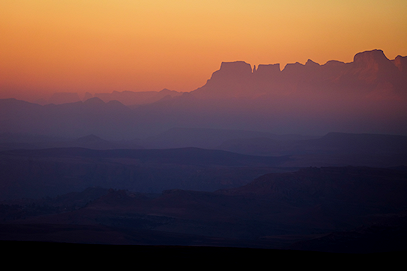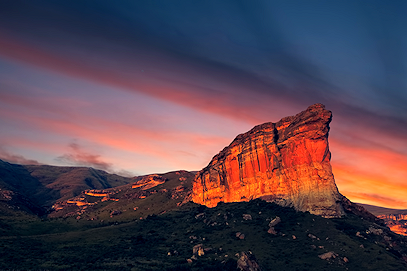Golden Gate National Park is adjacent to the Maluti Mountains in the eastern Free State. The Park encompasses 48 square kilometers of grassland and spectacular sandstone formations. Its primary purpose is to protect the sandstone cliffs above the Little Caledon Valley. African Sky could propose a custom itinerary that includes a visit to Golden Gate.
Need Advice?Golden Gate derives its name from the towering 100-meter-high golden-yellow sandstone cliffs – the "Golden Gates" – that flank the valley of the Little Caledon River at the western entrance of the park.

Black wildebeest, grey rhebok, oribi, blesbok, and mountain reedbuck can roam Golden Gate National Park. It is also home to the endangered bearded vulture, black eagle, and steppe buzzard. The natural attributes of the Golden Gate National Park make it an outstanding outdoor classroom for studying the earth sciences of geography and geology. It also provides opportunities for practical interaction with the environment.
In addition to the various traditional safari activities, the Park offers a unique cultural experience in the form of a tour of the Basotho Cultural Village. It is truly an honor to experience the traditional hospitality of the Sotho people who have called this piece of land home for hundreds of years. Their culture and spirit will leave you amazed.
As the sun sets over the mountains and valleys, the reserve is transformed into a place of pure magic. The rock faces glow with color, and like the kingdoms of days gone past, the famous gates are draped in gold. You are automatically transported into a film-like setting; you can almost see Simba climbing to the top of Pride Rock.
Set against towering mountains and seemingly endless grasslands, birding in the Golden Gate National Park is an absolute treat. Raptors such as eagles and falcons can be seen circling high in the skies, and even the threatened bearded vulture calls these outcrops home. A closer look around will illuminate a diverse range of unique grassland species.
Visiting Golden Gate National Park allows travelers to experience one of South Africa's more off-the-beaten-track destinations. This place is revered for its striking natural beauty and low visitor traffic.



Visitors can fly to any of the three international airports: OR Tambo International Airport in Johannesburg, King Shaka International Airport in Durban, and Bloemfontein International Airport in Bloemfontein. Alternatively, guests will be transferred from a previous destination on the safari itinerary utilizing a private, air-conditioned vehicle.
The Golden Gate Highlands National Park is situated in the Free State close to the border of Lesotho and is located almost centrally between the major cities of Johannesburg, Durban, and Bloemfontein. The journey is approximately 350km from either location and can easily be reached from various destinations in South Africa on well-maintained tar roads.
The area primarily has summer rainfall, mainly occurring from October to April. The rainy season also brings notable thunderstorms. The winter, from May to September, can be freezing as snow and frost are frequently found on the mountain range. The Park can be visited throughout the year depending on your activity preferences, and its beauty is enthralling no matter the weather. It is important to remember that weather changes can occur suddenly due to their mountainous setting.
The Golden Gate Highlands National Park has a diverse history. Numerous people populated this area long before it was bought by the government and declared a National Park in 1963. Originally, the Bushmen or San hunter-gatherers occupied this land, which teemed with wildlife. They left signs of their existence via a vast array of rock paintings and stone tools in the National Park. High-detail paintings, mostly of eland, and much younger low-detail paintings of farmers on horseback, may be observed on the smooth rock faces. After occupying this area for thousands of years, the Bushman moved away in the early 1800s.
Voortrekkers, under Piet Retief's leadership, resided in the area for six days from the 23rd of September 1837. After Retief permitted his men to hunt game, his men returned with nine wagons full of African wild meat. It is a testament to the great natural abundance that occurred here. Multiple skirmishes happened in the area now Golden Gate, mostly between the Basotho under the leadership of Moshesh and the Boers of the Orange Free State, which became an independent republic in 1853.
The Golden Gate Highlands National Park is not your typical safari area. Instead of introducing any member of the Big Five, the park board opted to reintroduce vulnerable species like the sungazer lizard and water mongoose. You will find the threatened oribi among the many species of antelope in the Park. One might easily spot this rare creature on the 'Oribi Loop.' Other plains game species include black wildebeest, eland, blesbok, red hartebeest, mountain reedbuck and springbok. The dazzling Burchell's zebra might give you a perfect photo opportunity against the epic backdrops. There are no large predators that occur naturally, making this an ideal environment for hiking.
There is a good chance of spotting the very cunning black-backed jackal, and if you are fortunate, you might sneak a glance at the elusive caracal. This reserve also provides excellent birding. One of the key features is the 'vulture restaurant' where carcasses are dumped to feed Cape and bearded vultures. More than 210 bird species have been documented. The Park hosts many raptors, ranging from eagles to buzzards and kestrels. The bald ibis is a sought-after species, and there are also a wide variety of small birds like cisticolas and sunbirds. Seven snake species occur, including the highly venomous puff adder, mountain adder, and rinkhals.
Golden Gate is known for its terrain's main features: the geological variances that have created the famous cliff formations over millions of years and the distending grasslands that seem to climb the mountains. The famous cliffs are distinguished by their red, yellow, and dark basalt layers and are exceptionally brilliant as the sun sets. The variety of colors are accentuated by the strange contours of the rock formations caused by centuries of erosion in the form of rivers and streams. The layers were formed millions of years ago, and much of the area's history and previous terrain types can be interpreted by examining them.
The Park is also known as South Africa's only grassland national park, with over 60 species of grasses to be found. The Highland-Sourveld and the Themeda-Festuca veld dominate the veld, while woodland areas are predominantly Ouhout (Oldwood) and scattered protea. The Ouhout tree, which is part of the rose family, is another one of the Park's characteristic features; its warped, flaking barks and smooth leaves are seen everywhere. The Ouhout trees also bring an immense variety of beetles; 117 species have been documented among the Ouhout family in the Park.
For the more adventurous, there are opportunities to abseil off the multicolored cliffs or to canoe along the winding rivers. For the purists, game drives and many hiking trails take you deep into the wilderness. Horse, quad, and motorbike rides are also available and offer a unique way to take in the landscape and its various inhabitants. You can also dive into a natural rock pool close to the Glen Reenen Rest Camp.
The area also offers golfing opportunities, zip lining, archery, paintball shooting, and much more. A must-do, however, is a visit to the Basotho Cultural Village. This unique program highlights the area's cultural heritage and transports visitors back to when the 'Qwa Qwa' inhabited the area. The experience is guided by local experts and includes a medicinal trail and San rock art. Another popular attraction is the Vulture Feeding Project. A short 300m hike takes you to the viewing area from the car park. Visitors can also make their way to the Welbedacht Dam in the Southern part of the Park.